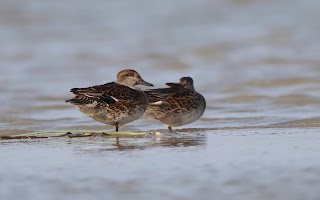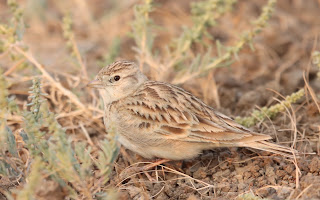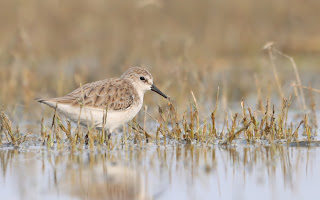Just came back from a wonderful tour to Little Rann of Kutch (LRK), Gujarat. I went on a birding tour after almost 2 years, thanks to the pandemic. So it was much awaited. I had visited LRK a few years back with my brother and hence initially was a little reluctant to visit the same place again. But my friend (and a great bird photographer), Sachin Pawar, had a great interest in visiting the place. I agreed to go on this trip only when we decided to take both my kids along with us and make this an all-boys trip.
When I put the trip proposal in front of my kids, both accepted instantly and you won't believe but there was absolutely no resistance from my wife. In fact, she was happier than us as she was going to get a chance to enjoy her solitude.
All the planning for the logistics support on the field was done by my friend. My job was rather simple, just to take care of the travel bookings. We decided to visit 2 locations during our trip, first was obviously LRK for 2 nights and second was Nal Sarovar for 1 night. While going to LRK, we booked ourselves on Pune-Ahmedabad Duronto train (my favorite train when it comes to traveling to Ahmedabad) and for the return journey booked us on a Go Air flight.
Day 1
Day 2
Our ride was waiting for us outside the station, so we got in and started the journey towards Patdi village. From my last trip to LRK, I remembered that enroute to Patdi, there is a dumpyard at Veerangam where we saw Vultures. We decided to visit the same spot and saw Egyptian Vultures which served to be our first sighting of the trip.
Both kids were super excited to see the endangered & the smallest species of Vultures. After observing and photographing the beautiful Vulture, we continued with our journey. It was expected to be a 3 hours journey to Patdi village but because of the breakfast break & Vulture break it took a little longer than that. We reached Ashirwad Hotel at Patdi around noon and after getting freshened up, moved on to have lunch.
Our first safari was scheduled for Bajana gate at 3pm. Our local guide, Bhura Singh, was very punctual and picked us from the hotel at 2:45pm. On the way to Bajana gate, we saw another beautiful bird named White Stork along with a few other commoners like Egrets, Ibises, etc. The big stork was friendly enough and gave us some good shots.
Our guide, Bhura ji, already paid for the permits to enter the Bajana gate. While roaming around the water bodies in the Bajana region, we saw a lot of birds. The highlights were Dalmatian Pelicans, Common Cranes, Greylag Geese and both Greater & Lesser Flamingos. The safari ended with a perfect shot of a majestic Imperial Eagle.
As we got to see many birds in the very first safari, we went to bed with very high hopes for the next day morning safari. The plan for the next day was to visit the Nava Talav region to cover waders and raptors.
Day 3
After making sure that we have some good shots, we decided to move on to explore the region further. From a distance, we saw that a Marsh Harrier dived into water to make a duck kill for breakfast. Our guide immediately turned our vehicle towards the scene. We got off the vehicle but wanted to go close to the bird so that we could get good shots of the feast. There was no way that we could walk towards the bird, so the only way was to crawl. The problem was mud.
Initially, kids were a little hesitant to crawl. But looking at me & my friend, they also joined the party and we all were crawling in muddy soil full of bird droppings everywhere for a good 100 meters or so. Marsh Harrier was busy finishing its breakfast and was not at all bothered by us crawling towards it. While crawling we realized that there is an Imperial Eagle just sitting next to Marsh Harrier, perhaps waiting for its turn to feast.
After capturing both birds in our cameras we decided to back off to leave the birds alone and explore the region further. While roaming around we saw many species of birds. The highlights were a single Curlew, Bar-headed Geese, Common Teal Ducks, Greater Thick-knees, and an extremely shy White-tailed Lapwing. The Common Sandpipers & Little Stints were so common that I was not even paying attention to those. One more highlight was, we even saw a face-off between Imperial Eagle (the winner) and Greater Spotted Eagle.
Greater Spotted Eagle on left, Eastern Imperial Eagle on right
Around 10:30am we decided to call off the safari and return back to the hotel for some food and rest. While returning from Nava Talav, we could not resist ourselves from stopping at the same spot where we saw Pied Avocets in the morning to get more shots of the same bird in better light conditions.
Bar-headed Geese taking off
The afternoon safari on Day 3 was planned to visit the Kharaghoda region for an Owl and raptors again. As soon as we reached Kharaghoda, kids were amazed to see big piles of salt everywhere. Kharaghoda is the place which has salt factories and our guide told us that 70% of the salt in our country is distributed from here.
We went further and drove through Rann for a long time. Kids had the first-time experience of seeing a mirage. They were all over the place. Initially, kids were not ready to believe that there is no water. But as we kept driving towards that and seeing that there was no sign of water, they were completely in awe. My younger son tried capturing it in his camera. The photo he managed to capture is not very clear but you can see a watery line near the horizon, that's a mirage.
We went further and drove through Rann for a long time. Kids had the first-time experience of seeing a mirage. They were all over the place. Initially, kids were not ready to believe that there is no water. But as we kept driving towards that and seeing that there was no sign of water, they were completely in awe. My younger son tried capturing it in his camera. The photo he managed to capture is not very clear but you can see a watery line near the horizon, that's a mirage.
This safari was relatively low on the count of bird species as compared to the first two safaris. But we still managed to see what we aimed for, which is a Short-eared Owl. Unlike most owls, this is one of the owls which is active in the daytime. The next one that we saw was a female Peregrine Falcon. Apart from the owl & falcon, we also saw a few Harriers and a Sparrowhawk.
We wanted to end the safari with a trademark sunset shot with Wild Ass in front. But the Wild Ass was not in a mood to give us that shot so this is all that we could manage.
We were back to the hotel with a slightly less fruitful safari but we were still happy as we could manage to see what we aimed for. Thanks to our guide! Usually, while on such birding trips, I like to follow Japanese culture of taking shower before going to bed rather than doing it in the morning. So I made my kids follow the same practice. In fact, after all the crawling that we did the whole day, a shower was necessary too.
Day 4
By this time, we became seasoned and spotted a couple of mammals & various birds one after another. The main highlights were Great White Pelicans, Crested Larks, Short-toed Larks, Sandgrouses, Desert Wheatears, Isabelline Shrikes, etc.
We kept this safari shorter as we had to check out from the hotel and go to our next destination i.e. Nal Sarovar. Another reason for wrapping up early was, before we go to Nal Sarovar, we wanted to get RTPCR tests done for my kids (negative RTPCR report is mandatory to enter in Maharashtra). Patdi being a small village, there was absolutely no facility for doing the tests in the village. So we had to travel to nearby town Sanand, where we found a Pathological lab that performs RTPCR tests.
One more problem that we faced in Patdi was paying the bills. Neither hotel nor guide were ready to accept payment by GPay or Credit Cards. Everyone was expecting cash payments. There was an ATM just in front of the hotel where we stayed but I never saw it open in my 3-days stay. Our guide took me to another ATM in the bazaar region, but it had no cash. It was hard to believe all this, especially after the rise in acceptance of plastic / digital money after the demonetization. The manager at the hotel said that we can get some cash at the nearby Petrol Pump by paying some service charge. So we went there and got some cash. Thankfully, both hotel manager & guide agreed to accept payment partially by GPay and partially by Cash.
So a big lesson, if you are traveling to Patdi or a smaller village like Patdi then don't expect any medical facilities and don't expect Gpay or Credit cards to work.
Anyway, after settling all the payments we left Patdi village and went to Sanand first (for RTPCR tests) and then continued our journey to Nal Sarovar. Upon reaching Nal Sarovar we were welcomed by another local guide, Mahmud Bhai. Since it was just a 1-night stay, we were booked in a homestay near Nal Sarovar which was referred to us by Mahmud Bhai.
After reaching homestay, we got ourselves freshened up and were ready for the evening safari. Our safari started with the search for a dove named Namaqua Dove, which I had never heard of before. After a good walk for half an hour in the blazing sun, we saw 1 female individual of Namaqua Dove. The information about this bird on the internet suggests that it may be an introduced bird in India.
Namaqua Dove (♀)
We waited at the same spot for a long time in the hope to see male Namaqua Dove but all went in vain. After all the hopes died, we started exploring the region and saw other birds like Grey-necked Bunting, Striolated Bunting, Red-headed Bunting, etc. Rather disappointing outing but that's all what we saw.
Dinner was awesome at the homestay. It was typical Gujarati Thali with a campfire. After having food, we decided to hit the bed early because we had an early morning safari the next day.
Day 5
While enjoying a boat ride through calm waters of Nal Sarovar, we saw lots of bird species including Wagtails, Cormorants, Sandpipers, Herons, Osprey, Rosy Starlings, Bank Mynas, etc. But the main highlights were Common Starling and Common Ringed Plover. We had to spend a lot of time in search of Common Ringed Plover, which was one of the rare birds that we saw.
Common Starling
Common Ringed Plover
Kids were tired by now as we were sitting in a tiny boat for more than 4 hrs with short bio-breaks on a couple of islands. Hats off to the person who was rowing the boat for all the time. That was quite an effort for the amount of money that we paid him. The last safari yielded a lot of waders, so we were happy. We returned back to the homestay but it got late than we anticipated so rather than having lunch at homestay, we decided to have it on our way back to Ahmedabad airport.
To end the trip, we took a flight from Ahmedabad and returned to Pune safely.
When asked about the homestay experience to my kids, I knew that my kids might not have liked the place much. And that's the exact response that I got from them. The reason was the homestay had Indian toiletries. Except for that part, they loved everything else.
Being a mix of marshy wetlands with a salt cover and arid barren land, the Little Rann of Kutch may not excite you with its bland topography, but believe me it is a birder's delight. We saw almost 90+ bird species during our trip and I have not even included very common birds in my list. Special thanks to my friend, Sachin Pawar, who took all the effort to find those well knowledgeable local guides. Kids also enjoyed the trip thoroughly and are already excited to plan the next one.
In the end, describing my experience is very simple. Gen Z is happy.. so Gen X is happy too!


















































Great pics !!!
ReplyDeleteBeautiful blog and photographs 😊🙏
ReplyDeleteGood writ up and nice arrangement of photos!
ReplyDeleteAwesome Images Buddy... Kindly share the number of Bhura Singh Ji
ReplyDeleteKhup chhan varnan kela ahe...
ReplyDeleteBeautiful captures and good write-up
ReplyDeleteLoved it
ReplyDeleteGreat work baba!
ReplyDeleteLoved reading this and the pictures are brilliant
ReplyDeleteWonderful experience on that tour.
ReplyDeleteNice photos and well written too
ReplyDeletea good read, nice pictures
ReplyDelete